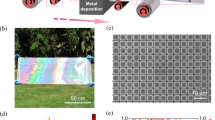Abstract
During recent decades organic light-emitting devices became of increasing interest in many fields of applications. A broad spectrum of available organic molecules can be used to fabricate organic light-emitting diodes (OLEDs) emitting at various photon energies. One of the commonly used quality criteria to specify the light output of OLEDs is the luminous efficiency. The standard measurements are based on the assumption of a point source, which is not applicable in the case of large-area devices, or can be achieved only approximately by long distances between emitter and detector. Therefore, we developed a data evaluation procedure, taking into account the extended area of the emitter as well as the geometry of the detector and its spectral sensitivity. This mathematical model delivers correction factors for the luminous efficiency as a function of the distance between a large-area emitter and a detector. The model was tested experimentally for rectangular-shaped OLED structures and delivered accurate results for three different standard types of detectors.
Similar content being viewed by others
References
Y. Shirota, H. Kageyama, Chem. Rev. 107, 953 (2007)
S.R. Forrest, Nature 428, 911 (2004)
S.R. Forrest, D.D.C. Bradley, M.E. Thompson, Adv. Mater. 15, 1043 (2003)
K. Müllen, U. Scherf, Organic Light Emitting Devices: Synthesis, Properties and Applications (Wiley, New York, 2006)
Y. Ohno, C.L. Cromer, J.E. Hardis, G. Eppeldauer, J. Illum. Eng. Soc. 23, 88 (1994)
H. Li, C. Zhang, D. Li, Y. Duan, J. Lumin. 122–123, 626 (2007)
C.L. Mulder, K. Celebi, K.M. Milaninia, M.A. Baldo, Appl. Phys. Lett. 90, 211109 (2007)
H. Peng, X. Zhu, J. Sun, Z. Xie, S. Xie, M. Wong, H.-S. Kwok, Appl. Phys. Lett. 87, 173505 (2005)
T. Höfler, M. Weinberger, W. Kern, S. Rentenberger, A. Pogantsch, Adv. Funct. Mater. 16, 2369 (2006)
Photo IC Diode S9648 Datasheet (Hamamatsu Photonics K.K., 2007). http://jp.hamamatsu.com/resources/products/ssd/pdf/s9648-100_kpic1057e03.pdf
High Accuracy Ambient Light Sensor – Datasheet SFH 5711 (Osram Opto Semiconductors GmbH, 2007). http://catalog.osramos.com/catalogue/catalogue.do;jsessionid=F010ED2DA6DB3A5EDFB07AD9E8A22D7E?act=downloadFile&favOid=0200000400001d65000100b6
Silicon Photodiode for the Visible Spectral Range BPW21 (Osram Opto Semiconductors GmbH, 2007). http://catalog.osramos.com/catalogue/catalogue.do;jsessionid=F010ED2DA6DB3A5EDFB07AD9E8A22D7E?act=downloadFile&favOid=020000020000890c000200b6
Ambient Light Sensors – General Application Note (Osram Opto Semiconductors GmbH, 2007). http://catalog.osramos.com/catalogue/catalogue.do;jsessionid=F010ED2DA6DB3A5EDFB07AD9E8A22D7E?act=downloadFile&favOid=0200000400003223000100b6
Author information
Authors and Affiliations
Corresponding author
Rights and permissions
About this article
Cite this article
Simbrunner, C., Hernandez-Sosa, G. & Sitter, H. Quantitative luminous efficiency determination for large-area light-emitting devices. Appl. Phys. A 98, 337–344 (2010). https://doi.org/10.1007/s00339-009-5401-1
Received:
Accepted:
Published:
Issue Date:
DOI: https://doi.org/10.1007/s00339-009-5401-1




